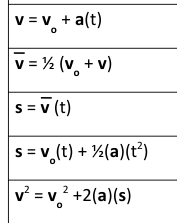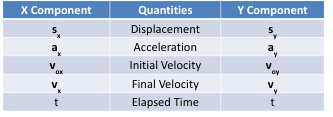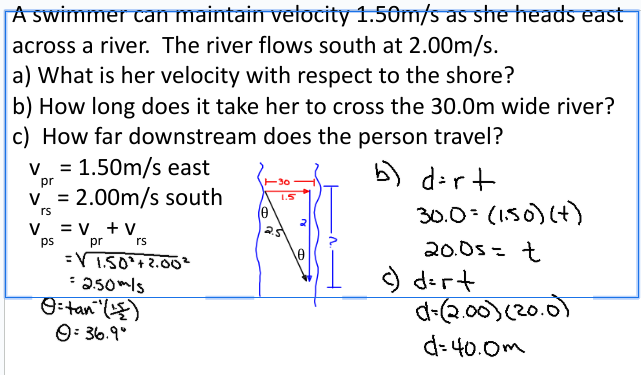Midterm Review
1/119
Name | Mastery | Learn | Test | Matching | Spaced |
|---|
No study sessions yet.
120 Terms
Significant Figure Rules
estimate one sig fig past smallest division on measuring device; every non-zero digit is significant; zeros between non-zeros are significant; leftmost zeros in front of non-zeros are not significant; zeros past a number to the right of a decimal are significant; zeros before understood decimals are not significant; zeros before indicated decimal are significant; counts and exact quantities are significant
Length Units
SI- meter (m)
CGS- centimeter (cm)
BE- foot (ft)
Mass units
SI- kilogram (kg)
CGS- gram (g)
BE- slug (sl)
Time units
SI- second (s)
CGS- second (s)
BE- second (s)
Adding and Subtracting Sig Figs
retain as many places to the right of the decimal as the original number with the least places after the decimal
Multiplying and Dividing with Sig Figs
retain as many sig figs as the original number with the least
Scientific Notion
shorthand for writing really big or really small numbers; * 10number
Scalars
quantitiy that only needs a magnitude (number with unit)
Scalars examples
time, temperatuer, mass, length, speed, distance
vectors
a quantity that needs a magnitude (number with a unit) and a direction to be complete
vectors examples
force, velocity, acceleration, displacement
resultant
R with arrow on top; result of combining two or more vectors
How do you calculate the resultant?
use a graph method by drawing the each vector and placing the tail of each next to the head of the previous; measure the angle and resultant OR vector component method to find x-component and y-component and using Pythagoras theorem to find resultant
equilibrant
RE with arrow on top; vector equal in magnitude to, but in the opposite direction of, the resultant
How do you calculate the equilibrant?
keep same magnitude of resultant and put in opposite direction; ex. south of East turns into North of West
Kinematics
study of motion
Speed
rate of change in distance; scalar quantity; no particular direction can be assigned; d/t
Distance
length between objects or points without regard to direction
Displacement
s; distances that have a specific direction; sign indicates direction of displacement (- is left or down)
Displacement Unit
SI- m
CGS- cm
BE- ft
Velocity
v; rate of change in displacement; vector quantity; NEED to specifiy a direction
Velocity Units
SI- m/s
CGS- cm/s
BE- ft/s
Instantaneous Velocity
rate of change in displacement (or distance) at a given instant
Acceleration
rate of change in velocity; vector quantity; points in direction of the CHANGE in velocity (speeding up and slowing down)
Acceleration Units
SI- m/s²
CGS- cm/s²
BE- ft/s²
Kinematics equation for constant acceleration

Position vs. Time Graphs
The slope is equal to velocity; If linear, v is constant (i.e. no acceleration); If linear and horizontal the object is stationary (i.e. the speed is zero); If linear, horizontal, and along the x-axis, the object is stationary at the origin; If the graph is not linear, the object’s velocity is changing. (i.e. the object is accelerating) The slope of the tangent line is equal to instantaneous velocity
Velocity vs. Time Graphs
The slope is equal to acceleration; If linear, a is constant (i.e. constant acceleration); If linear and horizontal the object is not accelerating (i.e. the speed is constant); If linear, horizontal, and along the x-axis, the object is stationary; If the graph is not linear, the object’s acceleration is varying; The slope of the tangent line is equal to instantaneous acceleration
Free Fall
object falls accelerating only because of gravity; outside forces like air resistance are neglected
Acceleration due to Gravity
Everything is accelerated towards earth at the same constant rate. For every second of freefall, an object speeds up 9.80m/s (usually negative); AP CB uses 10m/s²
Variables for two dimension kinematics
components of variables with x and y subscripts

How do you use trig to resolve quantities into components?
use trig (cos and sin) to split the quantity into components; solve for opposite and adjacent
Projectiles
any object that moves through air or space and is acted only by gravity (neglect air resistance/wind); ax = 0 m/s² and ay = -9.80 m/s²
Horizontal Projectile
a projectile that is launched with no initial upward angle; ex: rolling an object off of a table; voy = 0 m/s
Horizontal Projectile mathematically manipulate
know that ax = 0 m/s², voy = 0 m/s, and ay = -9.80 m/s²; use equations to solve
Vertical Projectile
a projectile that is launched with an initial upward angle; ex: cannonball being fired; has vox and voy
Vertical Projecile mathematically manipulate
know ax = 0 m/s² and ay = -9.8 m/s²; usually will be given angle and initial velocity or just the initial velocity components; use equations to solve
Relative Velocity frame of reference
the velocity of an object is relative to the observer
Relative velocity 1-D situations
vpg = vpe + veg; add if going in the same direction; make one negative if going in different directions
Relative Velocity 2-D situations
vps = vpr + vrs; need to use pythagorean theorem and have angles to solve using equations

Newton’s 2nd Law of Motion units
Si- kg, m/s², Newton
CGS- gram, cm/s², dyme (dyn)
BE- slug, ft/s², lb
Newton’s Law of Universal Gravitation stated
every particle in the universe exerts an attractive force on every other particle based on Fg= (G*m1m2)/r²
Newton’s Law of Universal Gravitation equation
Fg = (G * m1m2)/r²; Fg- force due to gravity; G- universal gravitational constant; m1- mass of object 1; m2- mass of object 2; r- distance between the object’s centers
acceleration due to gravity; determines the gravity of a planet; is Fg = m * g when objects are close to a planet’s surface
Normal Force (FN)
a component of force that a surface in contact with something exerts perpendicular to itself; opposite of gravity; without it we would accelerate downwards; if resting on horizontal, non-accelerating surface, FN = Fg
Apparent Weight
weight displayed that is different than Fg that arises from either acceleration or a non-horizontal surface; FN = Fg + Fapplied = mg + ma; ex: elevator
Fs; force that must be overcome to set an object into motion; depends on coefficient of static friction and amount of Normal Force present
Fsmax = μs FN
μs; dependent on surfaces in contact
FK; force that must be overcome to keep an object in motion; depends on coefficient of kinetic friction and amount of Normal Force present
Fk= μKFN
μK; dependent on surfaces in contat
Friction on an incline Fg ≠ FN
FN = F⊥
W = Flls; W = Fcos(angle)s
SI- J = N * m
CGS- erg = Dyne * cm
BE- ft * lb
W = ΔK; derived from F = ma where a is replaced by (v²-vo²)/2s
K = ½ m v²
Fspring= -k∆x; k is spring constant and ∆x is change in length
equal to the work done by spring; W = F * d changes into W = ½kx * x and then to Uspring = ½ k x2